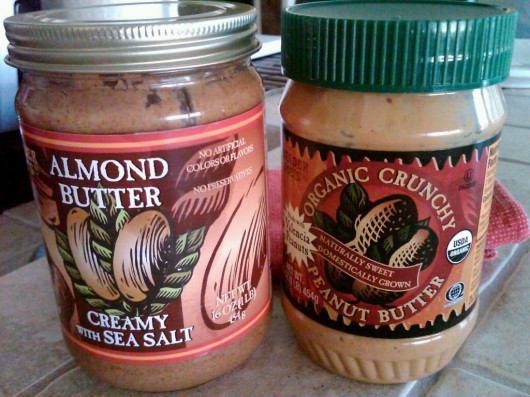I frequently hear people boasting that they “only eat almond butter” or “only eat raw cashew butter,” which leaves me wondering, what’s so wrong with good old peanut butter or all the other nut butters available these days? So I decided to do a nutritional comparison of the most popular nut butters. They’re more similar than different, but each kind of nut offers different benefits, so it’s best to eat a variety of the nut butters you enjoy. The only kinds I’d recommend avoiding are conventional peanut butters (the kind you don’t have to stir or refrigerate), as these types contain “partially hydrogenated oils,” which is code for “trans fats” (even if there is no trans fat listed per serving). And with the higher sugar flavored nut butters (like Nutella), think of them as more of a treat than a daily breakfast or lunch food.
| Type | Calories | Fat | Fiber | Protein | Sugar |
| Natural Peanut Butter
(the kind that separates) |
200 | 15g | 2g | 9g | 2g |
| Conventional Peanut Butter
(like Skippy, Jif, etc) |
190 | 16g | 2g | 8g | 3g |
| Reduced Fat Conventional Peanut Butter (like Reduced Fat Skippy, Jif, etc) | 190 | 12g | 1g | 8g | 4g |
| Almond Butter | 190 | 17g | 3g | 8g | 2g |
| Sunflower Seed Butter | 200 | 16g | 4g | 7g | 3g |
| Sesame Butter (Tahini) | 180 | 17g | 4g | 6g | 0g |
| Cashew Butter | 180 | 15g | 1g | 4g | 2g |
| Peanut Butter & Co Dark Chocolate Dreams (chocolate natural peanut butter) | 170 | 13g | 2g | 6g | 7g |
| Chocolate Hazelnut Butter (like Nutella) | 195 | 12g | 2g | 2g | 19g |







14 Comments
Deana
February 23, 2011 at 10:39 amGreat info! Any comment on the advice from Dr. Weil to avoid peanut butter because of the toxins found on peanuts?
Amelia
February 23, 2011 at 10:51 amI would just recommend buying organic peanut butter made from U.S. grown peanuts. As long as you’re buying organic, natural peanut butter, you can feel confident trusting the source. The toxic peanuts, and peanuts associated with the E.Coli outbreak were all in the cheap/processed PB and PB-containing products.
Elise Crane Derby
February 24, 2011 at 9:38 pmI’ve always heard that the main issue with peanut butter is the mold, and the tree/flower nuts don’t have that.
But some times a girl just needs a straight up PB&J on multi grain bread of course.
Amelia
February 25, 2011 at 12:02 pmAs long as you’re buying peanuts from a trusted source (look for organic and USA-grown peanuts) you can feel confident that your peanut butter is mold-free. Amen to PB&J’s!
kari
February 28, 2011 at 8:33 amso just to clarify…i really should give up the beloved JIF of my childhood for an organic peanut butter? i have never found another peanut butter that is as creamy and dreamy as JIF. hmmm, maybe i will (begrudgingly) take on a taste testing project and report back. this is going to be a difficult task but i think i’m up for the challenge!
Amelia
February 28, 2011 at 9:44 amIf you can stand to make JIF a very occasional treat, that’d be best!
tracy
September 21, 2012 at 5:32 pmBe cautioned that while organic is a federally regulated term, “natural” and “all natural” is not and is often used as a marketing tactic by brands that still use hydrogenation or modified sugars. This is particularly true of lots of nut butter brands showing up in the markets.
Taylor
March 9, 2013 at 6:36 pmThat’s actually not true; all peanuts, regardless of their organic or conventional natures, are subject to growing the aflatoxin mold. I have heard that peanuts grown in a dry climate, like New Mexico, are not as likely to have the toxin, however. A natural peanut butter brand that is grown with solely these peanuts, and so aflatoxin-free, is Arrowhead Mills.
Amelia
March 9, 2013 at 10:25 pmThanks for this information, Taylor – I appreciate it!
Ben
April 18, 2013 at 5:43 pmI buy this great product called “trilogy nut butter” …its a blend of cashew, walnut , and almond butter… Its delicious and gives the unique health benefits of each of these nuts blended into one source. They also have a trilogy butter that blends macadamia, cacao, and cherry. So good!!!
Check it out at their site: https://www.onnit.com/wac-trilogy-butter/?a_aid=Solstice
Amelia
April 20, 2013 at 12:11 pmThanks for the idea, Ben – this looks so delicious!
brian
June 11, 2013 at 12:42 pmIts not e.coli that is the problem with peanuts, peanuts contain aflatoxin and mold which is why no one should eat peanuts unless you get jungle peanuts which are a different variety that are grown aflatoxin free
Steven
April 11, 2016 at 3:02 pmSesame tahini has 20% protein, most b-vitamins, most minerals, and is more digestible than both almond butter and peanut butter. Peanut butter can cause intestinal problems because of the aflatoxin, which really limits its power as a gut-friendly, prebiotic food. It’s also extremely fattening, whereas tahini and almond butter actually help to regulate metabolism.
Amelia Winslow
April 13, 2016 at 12:51 pmI’m not sure how peanut butter could be “fattening” while other nut butters, despite the fact that it’s technically a legume as opposed to tree nut. On a biochemical level this doesn’t make sense. However, I agree that it’s a good idea to eat a wide variety of nuts and nut butters – instead of one of them all the time – for optimal health.